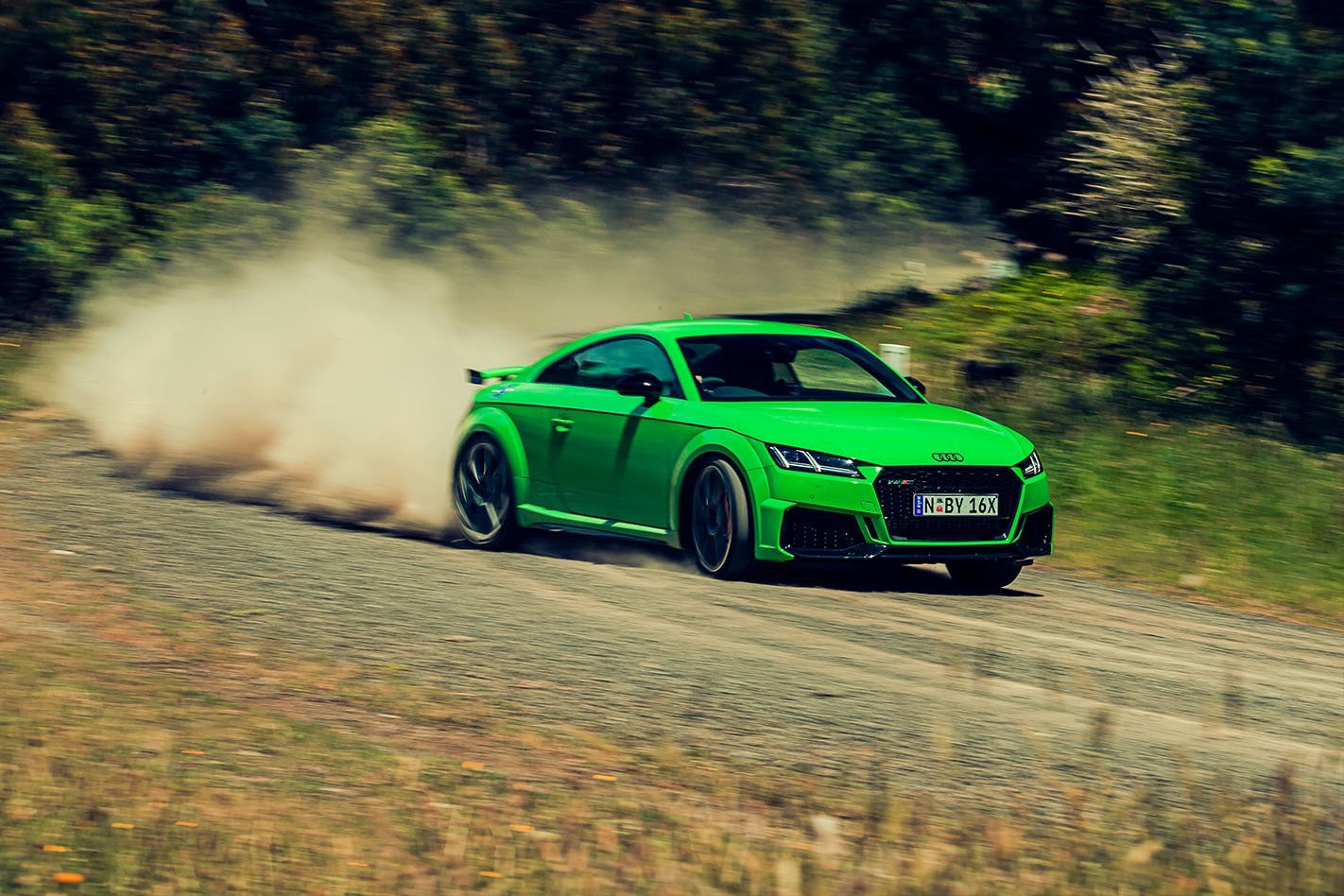Things we like
- Powerful, characterful engine
- Speed
- Grip
Not so much
- Choppy ride; road noise
- Useless rear seats
The highly-tuned five-cylinder barks in a steady rhythm, each successive prod of the throttle raising the revs ever higher. Each engine note question is swiftly answered by a crisp pop from the exhaust in a highly combustive game of call-and-response. A man in a brightly coloured vest holds out his hand and extends a finger at a time: “uno…due…tre…quattro…” His hand drops, as does the clutch, all four wheels sending rooster tails of earth into the sky.
It was here that Audi changed the face of rallying. While its rear-wheel drive rivals scrambled and slithered away from the start line the quattro surged; imagine asking any motorsport team if they’d like a five-second head start at the beginning of each race? Add that up over a 15-20 stage rally and you can see why all-wheel drive quickly became the technology of choice for loose surface competition.
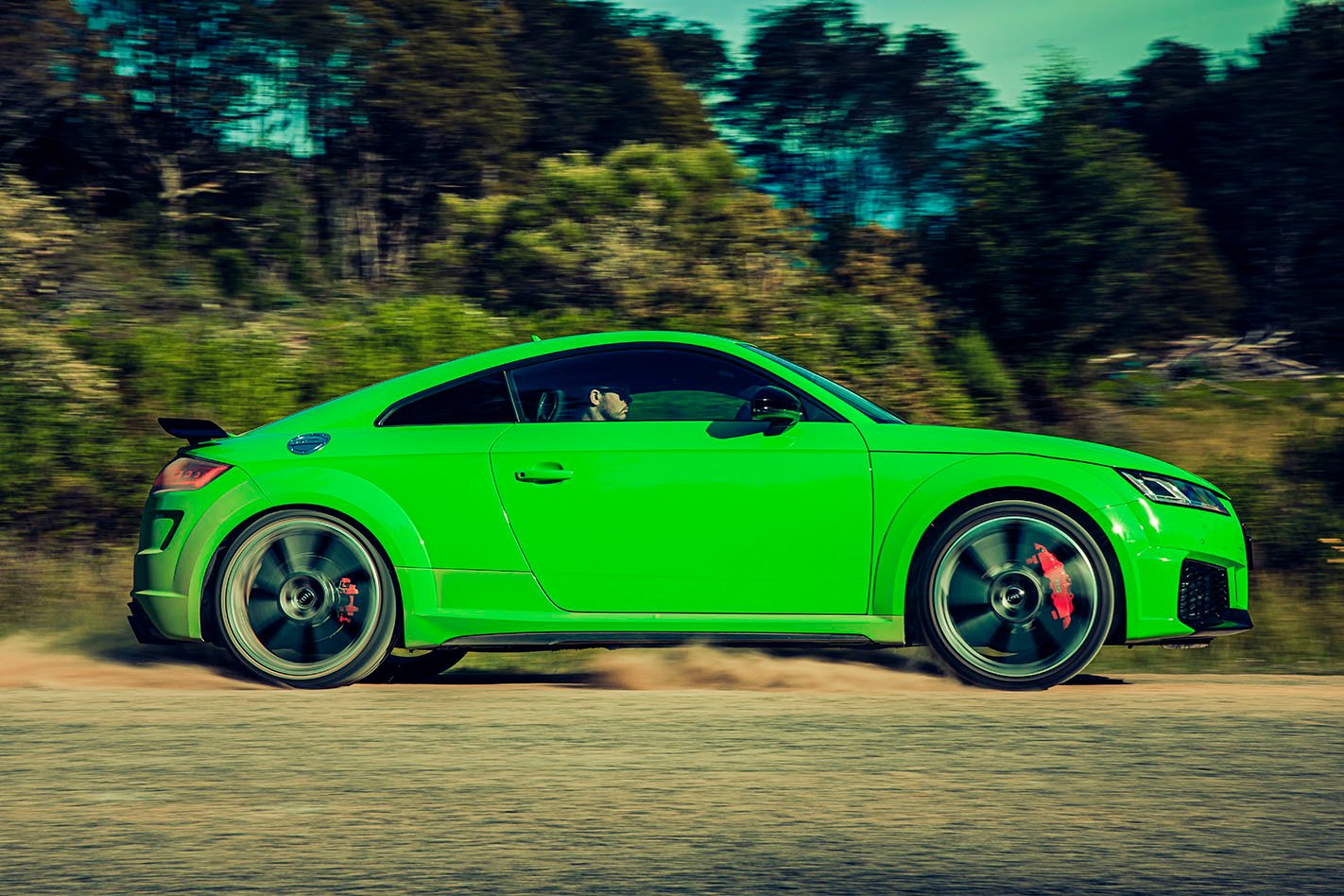
But it wasn’t all plain sailing. Despite Audi’s enormous technological advantage, the strain of the associated power and weight took its toll and unreliability allowed the 1981 and 1982 WRC titles to fall to lighter, nimbler and, crucially, more reliable two-wheel drive opposition. However, as the Group B regulations took hold and sent power outputs soaring Audi’s advantage only grew culminating in back-to-back titles for Hannu Mikkola in 1983 (see pg. 86) and Stig Blomqvist in 1984.
This, perhaps unexpectedly, brings us to the latest TT RS. During the 1984 season Audi developed the short-wheelbase Sport quattro. In an effort to improve its predecessor’s somewhat ponderous handling, particularly on tarmac, the engineers cut 320mm out of the wheelbase, increasing agility and removing weight while also extracting more power from the engine. Compare the specifications of the competition Sport quattro, dubbed ‘S1’, with the latest TT RS and it’s clear the two are kindred spirits.
The two are almost identical in size, the newer car just 41mm longer, 15mm wider and 4mm taller. Both use turbocharged five-cylinder engines, though while the S1 has a 345cc deficit (2135cc vs 2480cc) the outputs are, again, virtually identical: 298kW at 7500rpm and 460Nm at 5500rpm for the S1; 294kW from 5850-7000rpm and 480Nm from 1700-5850rpm, the newer car’s torque spread a clear indicator of 35 years’ advancement inturbo technology. Even the firing orders are the same, 1-2-4-5-3, if you’re interested.
Given the two car’s on-paper similarities, can the newly facelifted TT RS follow in its grandfather’s footsteps as an all-surface assassin? We’ll forgive you for not realising there was a ‘new’ TT RS. It’s a facelift in the truest sense of the word with redesigned front and rear ends, including larger air intakes at the front, a new rear wing, vents behind the rear wheels and a new diffuser design. Audi says “the TT RS has never been this masculine”. True. It’s certainly a long way from the rounded, unadorned, Bauhaus-inspired original – sharper, more aggressive, less ‘pretty’.
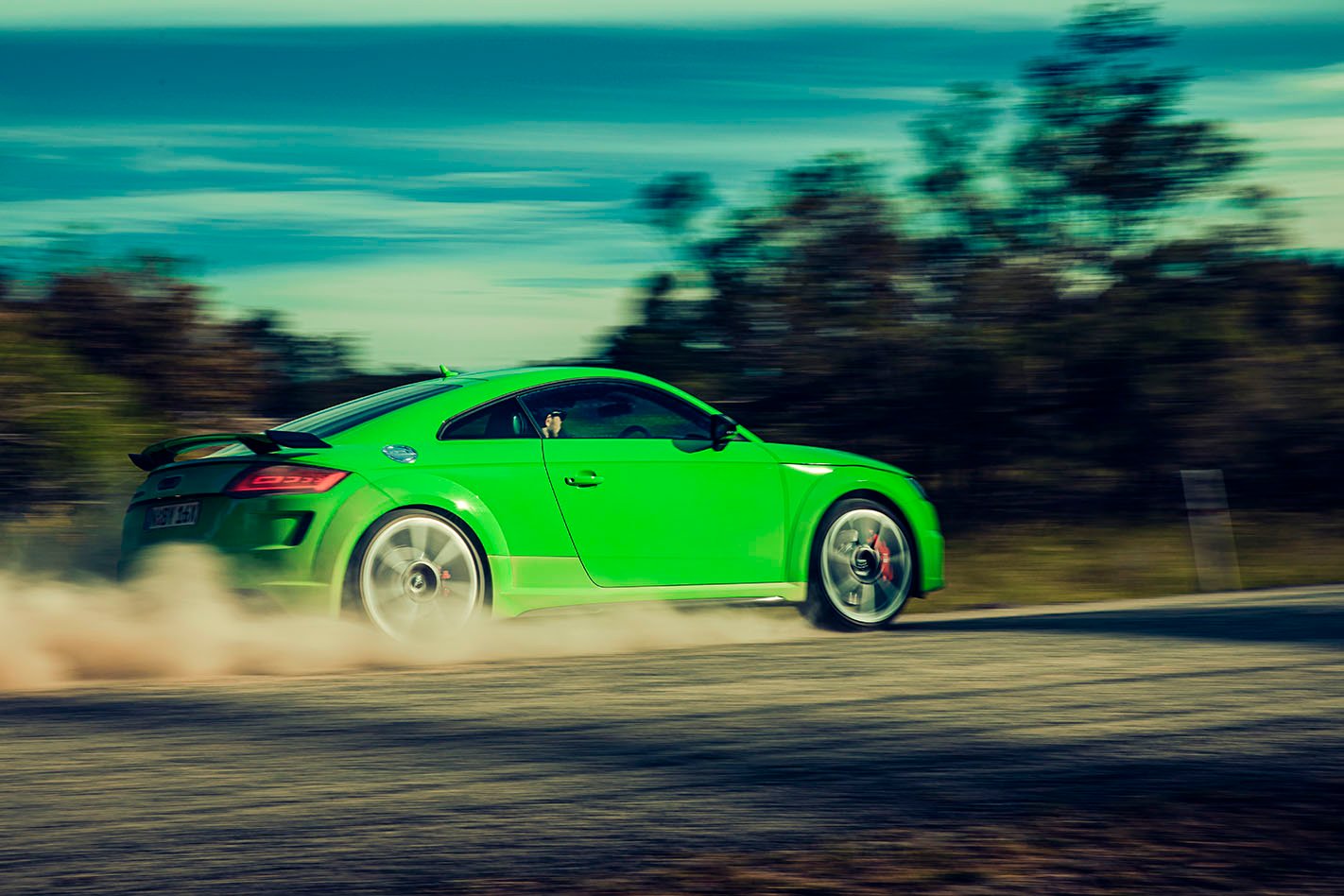
The TT has long carried a ‘hairdresser’s’ label, despite the fact it’s been offering true sports car performance for almost two decades; the first-gen (8N) V6 was interesting and the 1.8T quattro Sport promising, while the second-gen (8J) TT S was an under-rated gem, this very magazine decreeing: “After thrashing the new TT S at Wakefield Park you can call us all hairdressers.” It appears the TT RS has earned the respect of the Audi cognoscenti, however, judging by the raised finger of acknowledgement (no, not that finger) from the B5 RS4 driver who spots our Kyalami Green test car passing through Traralgon. Well, he could hardly miss it, could he?
The mechanicals carry over, but there wasn’t a lot of need for change. Audi claims 3.7sec from 0-100km/h but we clocked the previous TT RS at 3.59sec during testing Performance Car of the Year 2018 and it kept hauling to an 11.75sec quarter mile at 191.89km/h. Supercar speed for sports car money. It’s a cracking engine, a nine-time consecutive winner of the International Engine of the Year 2.0-2.5L category. While it’s found in a range of Audis, the 2.5 five-pot has less weight to push in the TT RS than in any other model and subsequently is at its most potent in this application.
Maximum torque is on tap from just 1700rpm so there’s ample urge down low, handy if you find yourself a gear too high through a corner. Despite being substantially under square with an 82.5mm bore and 92.8mm stroke, it spins easily to its 7000rpm redline with a characteristic off-beat gurgle like it’s trying to sing underwater. A six-speed manual would be a sweet fit for this car, but the seven-speed dual-clutch is an appropriate partner; the evolution of the Sport quattro, the wild S1 E2 (see breakout) was the first Audi to use a dual-clutch gearbox way back in 1985!
There’s a certain thrill to the uninterrupted delivery of power this clever transmission provides, especially in a car this quick. The TT RS is absolutely one of those cars that requires a weather eye on the speedometer at all times. Its combination of cornering grip, total traction and ample stonk means it accrues speed incredibly quickly and easily. The 2505mm wheelbase is much closer to that of the original quattro than the truncated S1 but the ultimate TT has no shortage of agility, each movement of the steering wheel eliciting an instantaneous response.
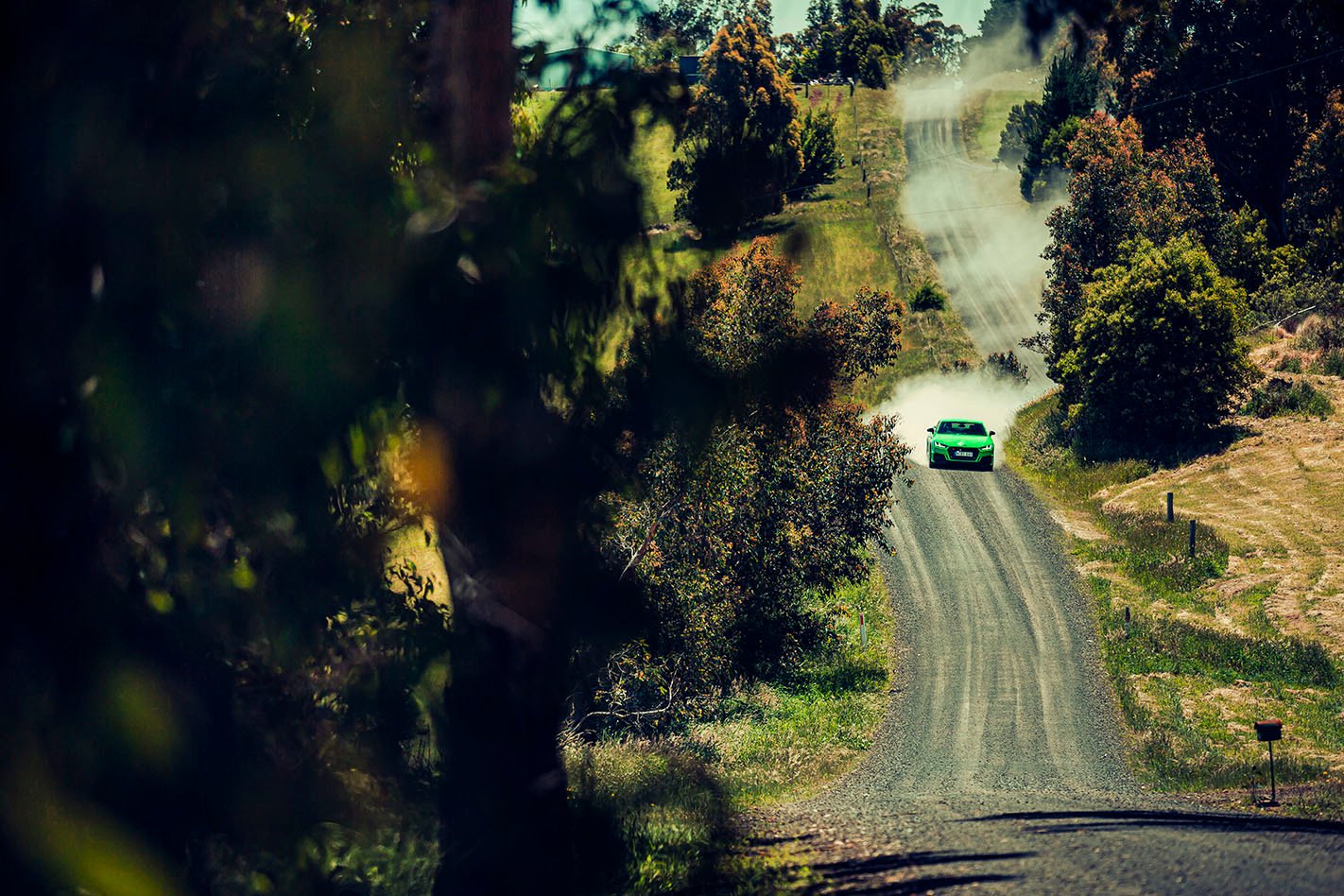
One thing the TT RS has inherited from its forebears is a predilection for push. Of course, it doesn’t plough like its 1980s predecessors, which often resolutely refused to change their course from the straight-ahead. The Sport quattro’s decidedly unfavourable 62:38 weight distribution did it no favours, but the rudimentary centre diff, which split drive 50:50, also didn’t help. To make matters worse, reliability problems sometimes led Audi to delete the centre diff entirely which only exacerbated its handling difficulties. Walter Rohrl described the technique of driving the quattro as akin to the Olympic sport of “throwing the hammer”.
Thankfully, the TT RS has no such affliction. Nevertheless, while the all-alloy five-cylinder introduced in 2018 improved the weight distribution by a single percentage point by removing 26kg out of the nose, it remains a front-heavy 59:41 and the handling reflects this. While lateral limits are extremely high, eventually the front tyres begin a gentle slide into understeer; it’s slightly difficult to know exactly where this point is, but as the kilometres pass and experience builds you can feel when the scrub starts, wait, then put the quattro system to good use on corner exit.
Driving well isn’t a requirement to go quickly in a TT RS, its make-up capable of flattering lazy or abrupt inputs, but it’s surprising how much happier the car is if you do so. That’s true for every car, of course, but while Audi’s all-wheel drive allows the throttle to be mashed with impunity, a little progression goes a long way towards letting the tyres work to their maximum. Smoothness becomes even more paramount on loose surfaces. It’s reasonable to assume that very few TT RSs – or Audis of any kind, really – will ever venture onto the gravel but perhaps they should, for it opens the door to a room of capability that would otherwise go undiscovered, though snow would work just as well.
All of a sudden, that unusual weight distribution can be used to the driver’s advantage, a lifted throttle or trailed brake swinging the rear end loose which can then be held there using the throttle. The quattro system that offers no hint of throttle adjustability on asphalt proves there’s truth to Audi’s claims of a greater rear drive bias on RS models. Our route has morphed from Rally Spain, relentless tarmac twists and turns with gravel-strewn apexes where corners have been cut, to Rally Finland, smooth, wide but slippery dirt roads with the rollercoaster topography of the fearsome Ouninpohja stage.
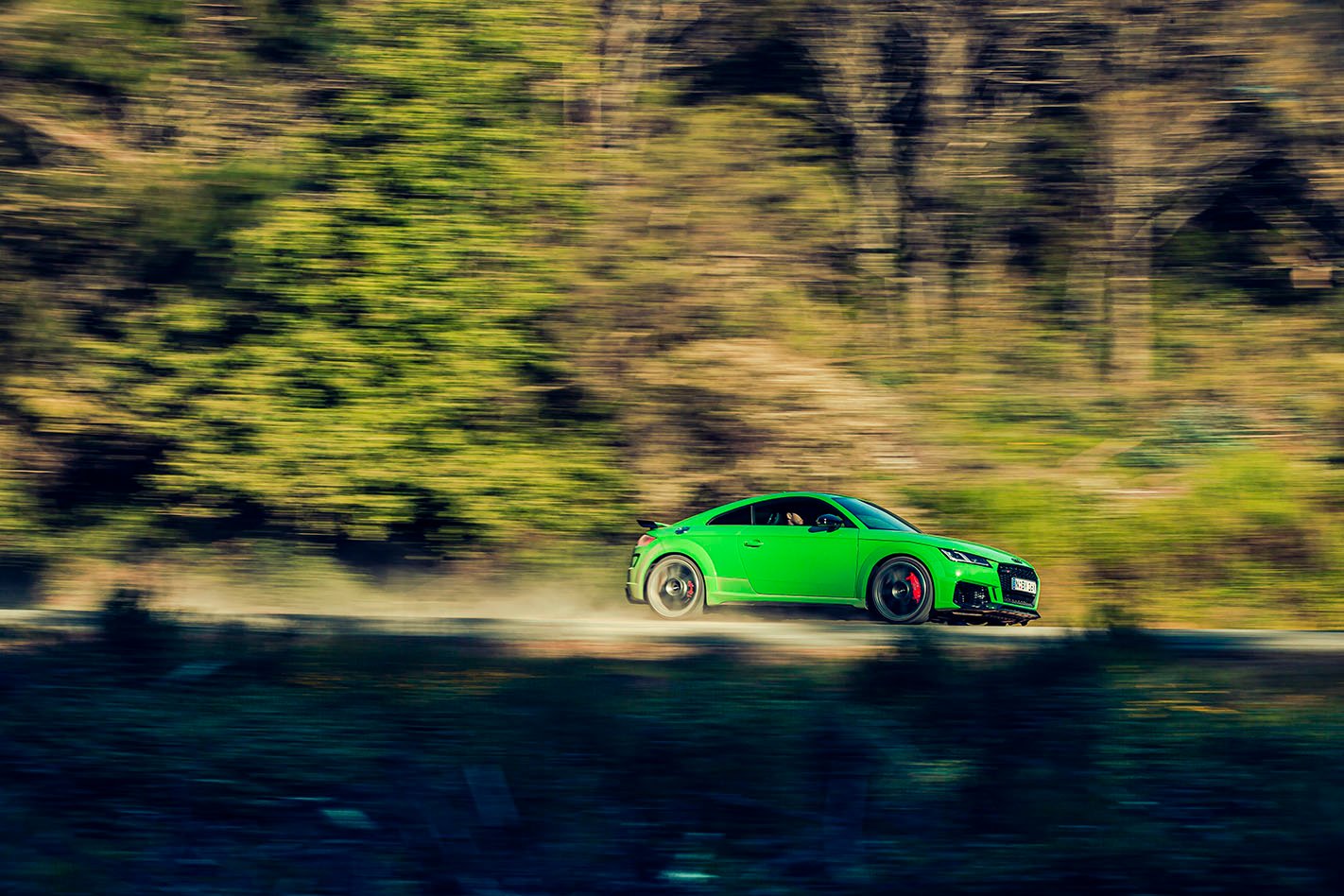
This decidedly road-focused coupe feels surprisingly at home. While choreographing the opener to this feature, it feels like the TT RS ‘learns’ the available grip. Lacking aggressive, knobbly rally tyres it doesn’t quite shoot off the line like its competition predecessors but each successive launch is cleaner than the last. On the first it wheelspins wildly, smashing into the rev limiter; on the second there is less furious wheelspin and a shift to second, while on the third it almost immediately upchanges to maximise grip. A sub-5sec 0-100km/h sprint on gravel wouldn’t be a surprising result.
It isn’t all Weissbier and skittles, however. There is a degree of less is more with the TT range, the base model possessing a sweetness and delicacy that the RS replaces with brute force: more power, more brakes, more grip and more speed but without necessarily any more fun. The chassis is compromised, skipping over a bumpy road rather than keying into it. The rear in particularly feels very stiff, the ride turning choppy on poor surfaces, sometimes brutally so. Speed humps can be a wince-inducing affair and the suspension can be quite noisy, clattering away over small amplitude bumps.
Road noise is also substantial; it’s a good thing there’s a powerful stereo, but Bluetooth conversations at highway speed necessitate a careful ear and a raised voice. Audi calls the the TT RS a “2+2” but it’s closer to a 2+0; it’s difficult to imagine what sort of human could fit comfortably on the short, upright bench. That’s probably fitting, as I can’t imagine chopping 320mm out of the quattro’s wheelbase did much for the Sport quattro’s rear accommodation. I drop the apologetic rear seats to see if it provides greater amplification of the five-cylinder exhaust note but sadly the only result is a pronounced Megane-like turbo whoosh. The upside ofmaking the TT a pure two-seater is excellent luggage space, the decent 305-litre boot swelling to 712 litres.
Despite its flaws, the TT RS is a weapon. At full pace, it’ll have adrenaline coursing through your veins and your eyes out on stalks; while it prefers smoothness it’s not averse to being bullied, flitting from apex to apex, the chassis not alive with feel but providing reassuring confidence. A word for the brakes, too; in a world where many cars still have lacklustre stoppers, the monster 370mm discs with eight-piston calipers on the front of the RS, backed by 310mm discs and four-piston calipers at the rear, are a welcome inclusion.
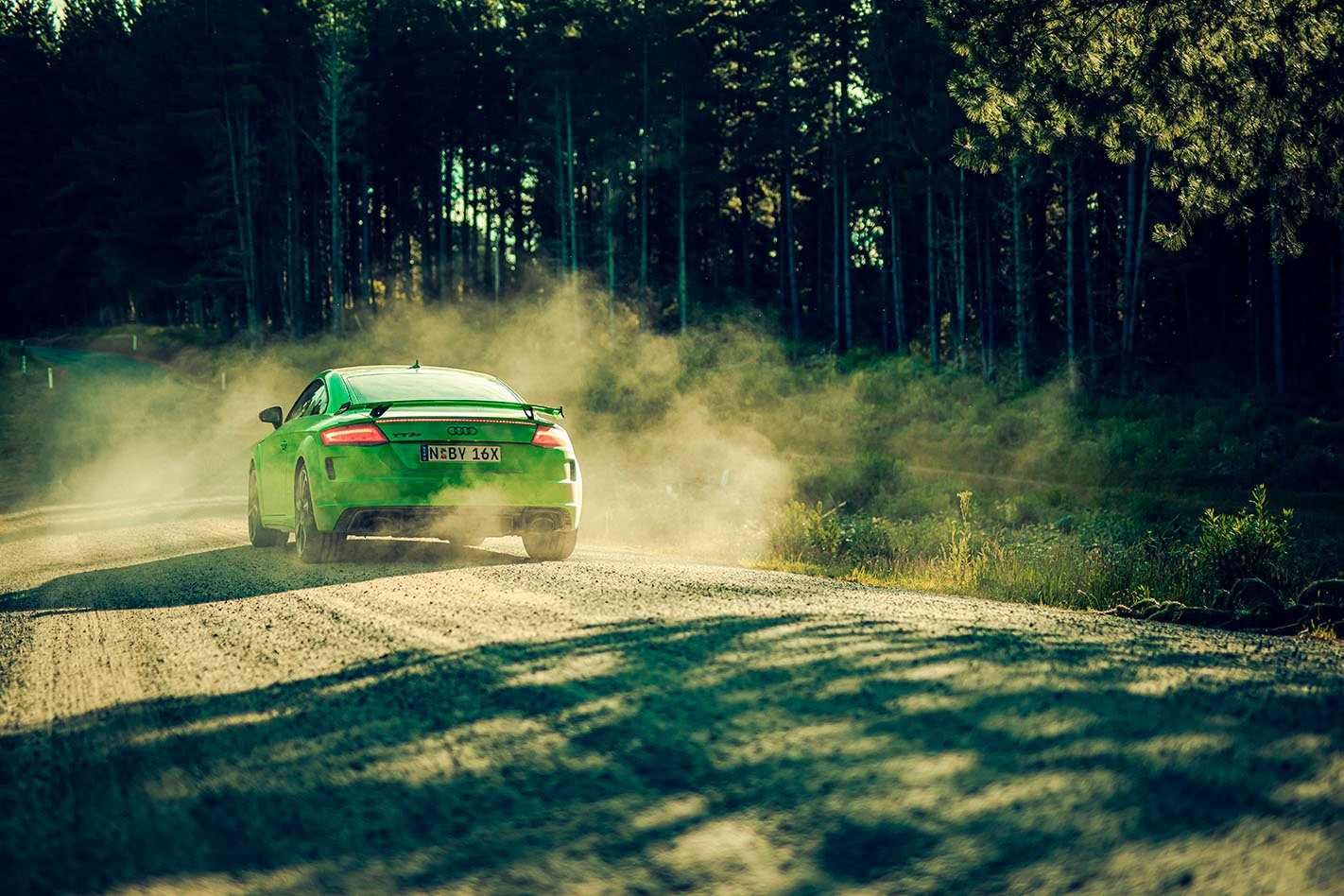
As such it would be a shame if these words are the TT’s epitaph, but there’s a distinct possibility that this will be the case. In May 2019 Audi’s interim chairman, Bram Schot, told media that there would not be a new TT, its replacement instead being “a new emotive model in the same price range.” Subsequent reports suggest that model will be an all-electric coupe-like crossover – whether that qualifies as an “emotive model” perhaps depends on your interpretation.
Electrification will be a quantum leap for all-wheel drive, offering hitherto unknown levels of traction, torque and tuneability thanks to the potential to gift each wheel its own individual motor. As such, quattro is potentially entering a golden age. It will fire off the line faster than ever regardless of the surface, but the lack of that rhythmic five-cylinder bark signifies the passing of an era.
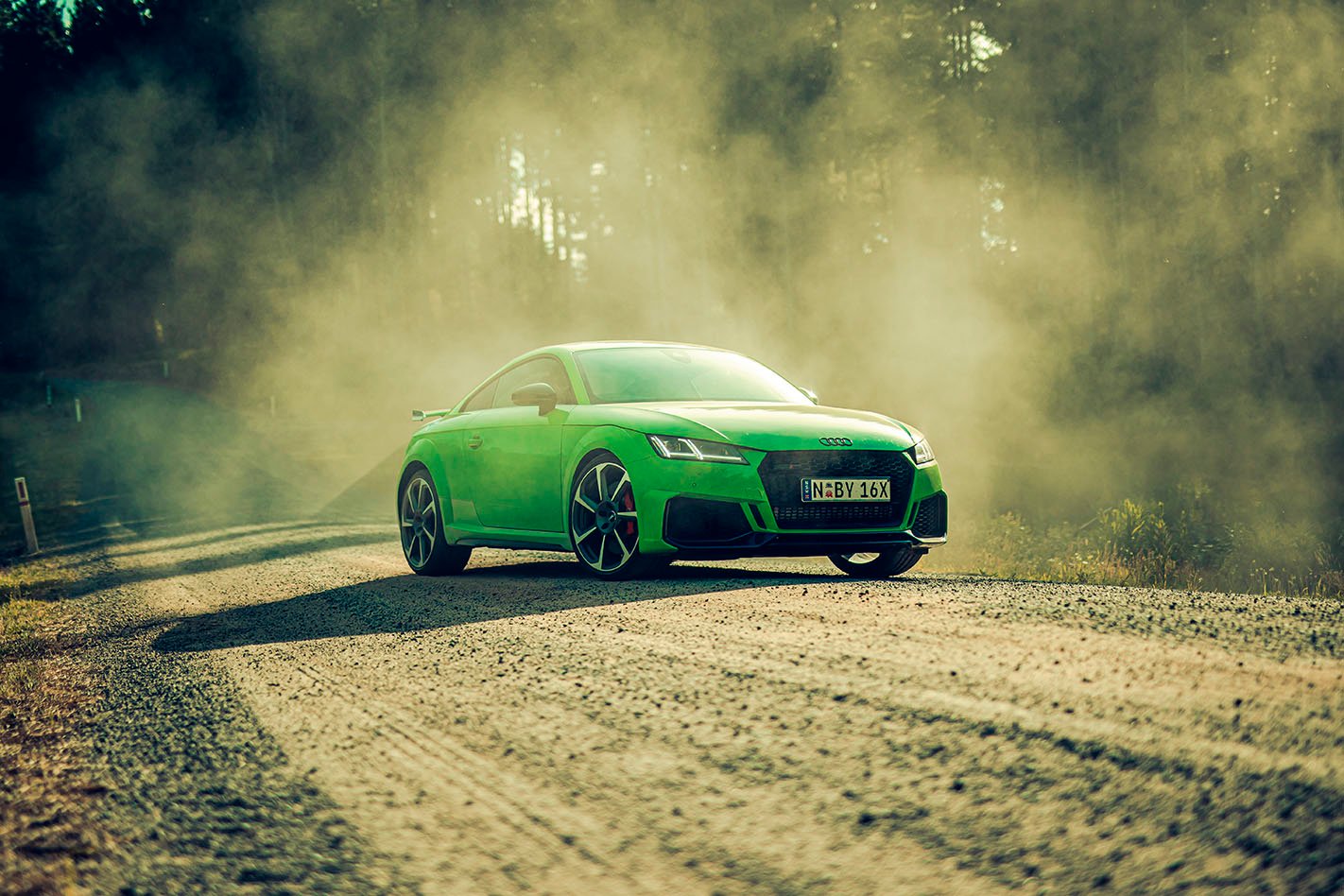
KING QUATTRO
AUDI’S ALL-wheel drive advantage quickly evaporated during the Group B era. Peugeot changed the game with its wild 205 T16, a mid-engined, featherweight flyer; Audi might have won both the 1984 drivers’ and manufacturers’ title but Peugeot dominated the last three rounds it entered, putting the writing firmly on the wall for more traditional machinery. Audi responded as best it could: the S1 ‘Evolution 2’ produced up to 410kW, massive wings generated 500kg of downforce, a Torsen variable-drive centre diff was added and everything possible – radiators, oil coolers, alternator – was moved to the boot, improving the weight distribution to 51:49 front-to-rear. Acceleration was mind-blowing, the E2 clocking 0-100km/h in 3.1sec and a 10.8sec quarter mile. Sadly, the car’s success was limited, Walter Rohrl scoring the E2’s sole victory at San Remo in 1985.
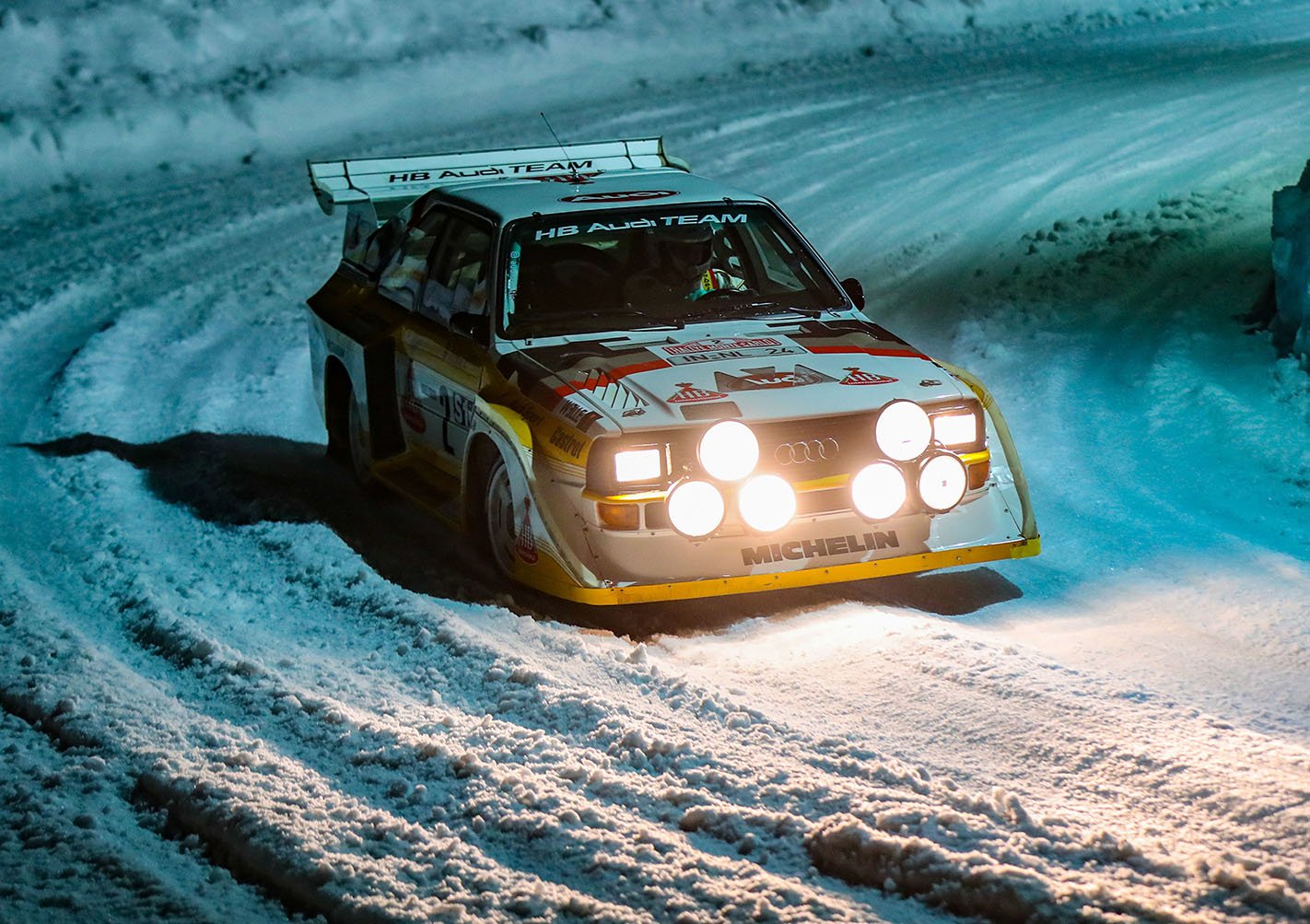
AUDI TT RS SPECS
- Body: 2-door, 2+2-seat coupe
- Drive: all-wheel
- Engine: 2480cc inline-5, DOHC, 20v, turbocharger
- Bore/Stroke: 82.5 x 92.8mm
- Compression: 10.0:1
- Power: 294kW @ 5850-7000rpm
- Torque: 480Nm @ 1700-5850rpm
- Power/Weight: 203kW/tonne
- Transmission: 7-speed dual-clutch
- Weight: 1450kg
- Suspension: struts, adaptive dampers, coil springs, anti-roll bar (f); multi-links, adaptive dampers, coil springs, anti-roll bar (r)
- L/W/H: 4201/1832/1344mm
- Wheelbase: 2505mm
- Tracks: 1564/1543mm
- Steering: electrically assisted rack-and-pinion
- Brakes: 370mm ventilated/drilled discs, 8-piston calipers (f); 310mm ventilated/drilled discs, 4-piston calipers (r)
- Wheels: 20.0 x 9.0-inch (f/r)
- Tyres: 255/30 R20 (f/r); Pirelli P Zero
- Price as tested: $134,900
Things we like
- Powerful, characterful engine
- Speed
- Grip
Not so much
- Choppy ride; road noise
- Useless rear seats


